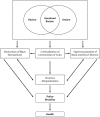Mechanisms Connecting Police Brutality, Intersectionality, and Women's Health Over the Life Course
- PMID: 36696613
- PMCID: PMC9877369
- DOI: 10.2105/AJPH.2022.307064
Mechanisms Connecting Police Brutality, Intersectionality, and Women's Health Over the Life Course
Abstract
Police brutality harms women. Structural racism and structural sexism expose women of color to police brutality through 4 interrelated mechanisms: (1) desecration of Black womanhood, (2) criminalization of communities of color, (3) hypersexualization of Black and Brown women, and (4) vicarious marginalization. We analyze intersectionality as a framework for understanding racial and gender determinants of police brutality, arguing that public health research and policy must consider how complex intersections of these determinants and their contextual specificities shape the impact of police brutality on the health of racially minoritized women. We recommend that public health scholars (1) measure and analyze multiple sources of vulnerability to police brutality, (2) consider policies and interventions within the contexts of intersecting statuses, (3) center life course experiences of marginalized women, and (4) assess and make Whiteness visible. People who hold racial and gender power-who benefit from racist and sexist systems-must relinquish power and reject these benefits. Power and the benefits of power are what keep oppressive systems such as racism, sexism, and police brutality in place. (Am J Public Health. 2023;113(S1):S29-S36. https://doi.org/10.2105/AJPH.2022.307064).
Figures
Similar articles
-
Inequities in Anticipatory Stress of Police Brutality and Depressed Mood Among Women.J Racial Ethn Health Disparities. 2023 Oct;10(5):2104-2113. doi: 10.1007/s40615-022-01390-8. Epub 2022 Aug 17. J Racial Ethn Health Disparities. 2023. PMID: 35976605
-
Beyond "heartfelt condolences": A critical take on mainstream psychology's responses to anti-Black police brutality.Am Psychol. 2022 Apr;77(3):362-380. doi: 10.1037/amp0000899. Epub 2021 Dec 23. Am Psychol. 2022. PMID: 34941309
-
Police Brutality and Black Health: Setting the Agenda for Public Health Scholars.Am J Public Health. 2017 May;107(5):662-665. doi: 10.2105/AJPH.2017.303691. Epub 2017 Mar 21. Am J Public Health. 2017. PMID: 28323470 Free PMC article.
-
Contributions of Black psychology scholars to models of racism and health: Applying intersectionality to center Black women.Am Psychol. 2023 May-Jun;78(4):576-588. doi: 10.1037/amp0001141. Am Psychol. 2023. PMID: 37384509 Review.
-
War on Drugs Policing and Police Brutality.Subst Use Misuse. 2015;50(8-9):1188-94. doi: 10.3109/10826084.2015.1007669. Subst Use Misuse. 2015. PMID: 25775311 Free PMC article. Review.
Cited by
-
Criminal Justice, Arrests Data, and Structural Racism Measurement for Health Equity Research: Promises and Pitfalls.Health Serv Res. 2025 Jun;60(3):e14449. doi: 10.1111/1475-6773.14449. Epub 2025 Feb 11. Health Serv Res. 2025. PMID: 39933958 No abstract available.
-
Profiles of Black Emerging Adults Exposure to Racism-Based Police Violence and Associated Mental Health Outcomes.Emerg Adulthood. 2024 Jun;12(3):398-409. doi: 10.1177/21676968241240182. Epub 2024 Mar 26. Emerg Adulthood. 2024. PMID: 39397886 Free PMC article.
-
Anticipatory Violence and Health Among Black Adults in the United States.J Racial Ethn Health Disparities. 2025 Jan 7. doi: 10.1007/s40615-024-02257-w. Online ahead of print. J Racial Ethn Health Disparities. 2025. PMID: 39775744
-
Officer-Involved Killings of Unarmed Black People and Racial Disparities in Sleep Health.JAMA Intern Med. 2024 Apr 1;184(4):363-373. doi: 10.1001/jamainternmed.2023.8003. JAMA Intern Med. 2024. PMID: 38315465 Free PMC article.
-
Investigating the Black Birth Experience: A Race-Stratified Analysis of Preterm Birth Risk and Exposure to Metropolitan Statistical Area-Level Police-Related Deaths, US 2018-2019.J Urban Health. 2024 Jun;101(3):464-472. doi: 10.1007/s11524-024-00871-x. Epub 2024 May 16. J Urban Health. 2024. PMID: 38753137 Free PMC article.
References
-
- Bandes S. Patterns of injustice: police brutality in the courts. Buffalo Law Review. 1999;47(3):1275. doi: 10.2139/ssrn.165395. - DOI
-
- Chang S, Cooper FR, Rolnick AC. Race and gender and policing. Nevada Law Journal. 2020;21(3):885.
Publication types
MeSH terms
Grants and funding
LinkOut - more resources
Full Text Sources


